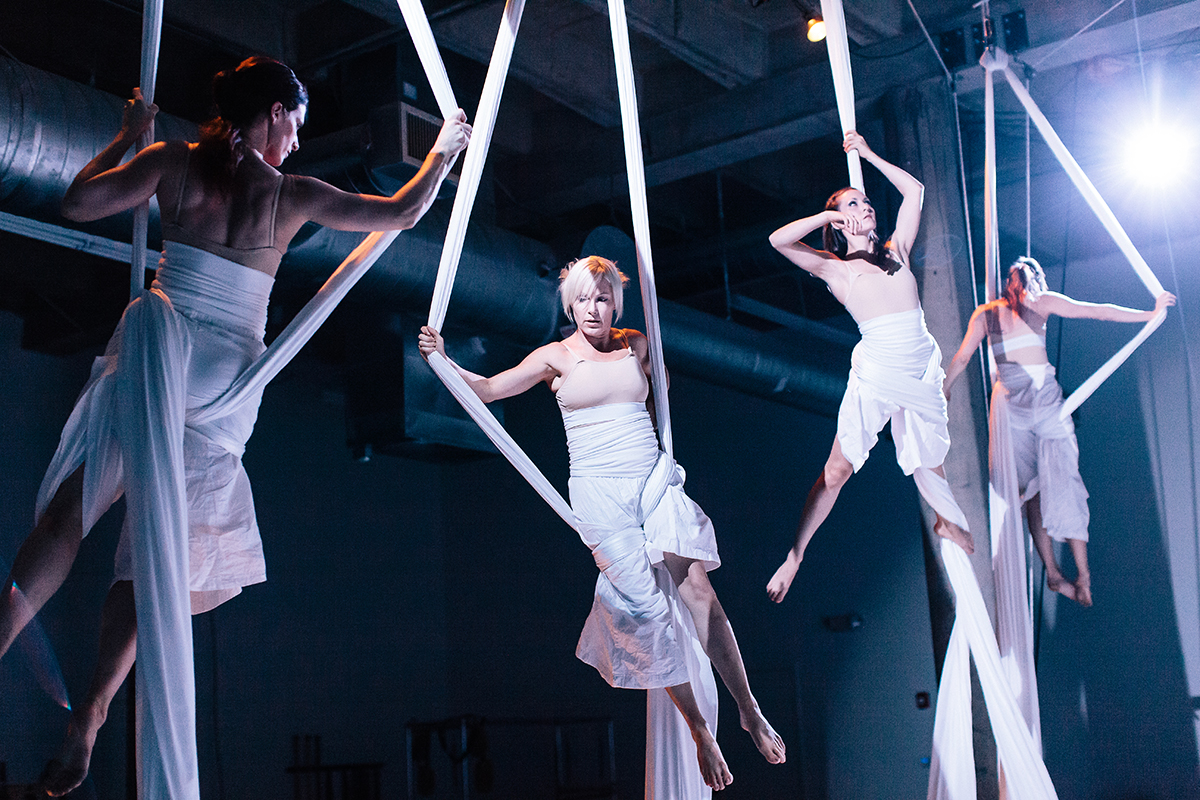VauLt Dance Company Thread

Strong Women, Flying High. Photo by Lynn Lane.
Spring Street Studios
Friday, October 19, 2012
VauLt Dance Company, choreographer Amy Ell’s performance company, inaugurated their new home in Spring Street Studios with an hour’s length program. Thread was the title given on the printed program handed out before the show, but some publicity had a subtitle:Stories of Eight Women and Their Lessons in Limitation.
The subtitle might have informed some audience members, but even knowing that the evening wasan exploration of women’s lives, the choreography was sufficiently abstract that I’d forgotten the particular theme as the show progressed. There was no lack for feminine imagery, as in the section wherein large swathes of silk, anchored at one end to the wall, the other end attached to the women’s waists, create billowy skirts with enormous trains. Still, at other times, the movement was less narrative and the imagery less concrete, leaving room to extract from (or project onto) the work several layers of meaning.
When I say the work has feminine imagery, it’s not a soft, demure femininity. The incredible physical strength of the dancers—at one point in my notes, I find the word “sinewy”—cannot help but convey that we’re watching strong women, however tender or vulnerable the emotion of the passing moment.
Before going any farther, I should note that VauLt performs aerial dance a particular form of contemporary performance. It’s a hybrid of modern dance and trapeze, seen perhaps most famously and grandly in shows by Cirque du Soleil. Aerial dance might be performed on a circus-type trapeze (as Ell has used in the past) or on aerial silks, which are long strips of cloth usually hung from the rafters (as Ell used inThread).
I first saw aerial dance, in person, a decade ago. There is always a certain amount of spectacle—a wow factor—in the form, just as there is in a trapeze act. There is usually some sense of danger as performers hang upside down precariously, trusting the friction of skin on fabric or the performers own strength to keep them safely aloft.
There are also conventions to the form. Performers wrapping silks around themselves has to be choreographed, perhaps trying to mask the task, perhaps not. Often there is the moment when a performer releases her grip and falls a distance before the carefully wrapped material catches and holds the performer. Then there is what I call the “climb and pose” aspect of aerial dance, which I trust is self-explanatory.
All these conventions appear in Thread, but just as a fantastic leap across a stage can be just a trick or a moment full of meaning or revelation, Ell’s choreography didn’t feel gratuitous or showy for its own sake. An intelligence and thoughtfulness supported each of these choices so that it was usually after the fact that I realized, “oh, that was the drop-and-catch moment.”
Speaking of intelligence, another mark of aerial dance is that it tends to be very vertical—climbing up, climbing down—without much room for horizontal movement beyond swinging. The performer is relegated to the area of the vertical line of the hanging apparatus. Ell smartly expanded that range of movement by hanging many silks in hammock style, close enough to each other so that performers could move one to the next and also up and down along the arc of the “hammock.” This added a welcome dimension to the movement.
The “climb and pose” moments sometimes created striking pictures. The strength required to hold them made them short-lived. (Have I mentioned the physical strength on display? Let it be mentioned again.) Still one image of women, heads and shoulders resting in the silks, faces obscured, feet resting in another hammock so that the bodies were suspended like planks, parallel to the floor—I wished for this to be a live art installation in a gallery so I could walk around and under them, take them in from other viewpoints in the room.
At the end of the show, I’m not sure I could articulate any new insight to women’s lives or that I caught everything of Ell’s intentions. I do think I can usually tell when an artist is working with ideas, trying to show us something, not just showing off. As I watched the moments of struggle and transcendence, I was with the performers, even if I can’t articulate exactly what was behind the wrestle and release. Ell and her dancers gave the audience an evening of striking images, full of strength and beauty.



Recent Comments